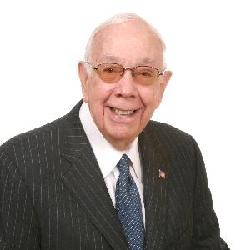 |
|
Rep. Paul G. Rogers, Washington's "Mr. Health" and Longtime Supporter of NLM, Dies at 87
Paul. G. Rogers, a retired US congressman known as "Mr. Health" for his leading role in passing dozens of measures promoting health care and the environment, died October 13 at Sibley Memorial Hospital in Washington, DC. He had lung cancer.

Rogers served for 24 years as a member of the U.S. House of Representatives, retiring in 1979. In the 1960s and 1970s, he was an ardent supporter of the National Library of Medicine on Capitol Hill.
For example, as a result of the "Rogers Report," emanating from the House Subcommittee on Reorganization, which he chaired, NLM established a research center for biomedical communications. That led to the Joint Resolution of the Congress that created the Lister Hill National Center for Biomedical Communications in 1968. That resolution also called for the construction of a new facility, the Lister Hill Center (Building 38A).
Rogers was also an advisor to NLM Director Dr. Donald A.B. Lindberg's long-range planning initiatives in the mid-1980s. In 1989, he served on the Library's Outreach Planning Panel, which issued an influential report on the importance of improving the dissemination of health information.
"Paul Rogers was one of the best friends the National Library of Medicine ever had," noted NLM Director Lindberg. "This courtly gentleman was at the same time an aggressive advocate for medical research. Although he hadn't trained in medicine himself, he had an uncanny ability to see the potential that medical research offered. He was always looking to the future and always had big, powerful ideas. We will miss him sorely."
As chair of the Subcommittee on Health and the Environment in his last eight years of office, Paul Rogers racked up a remarkable record of achievements in health policy. These include: the Migrant Health Act; the Clean Air Act; the Health Manpower Training Act; the National Cancer Act; the Heart, Lung, and Blood Act; the Emergency Medical Services Act; the Community Health Centers Act; the Medicare-Medicaid Anti-Fraud and Abuse Amendments; and the National Health Promotion and Disease Prevention Act.
Paul Rogers received the Distinguished Service Award from the NLM Board of Regents February 10, 2004. In presenting him with that honor, then-Board chair Eugenie Pride remarked, "The National Health Promotion and Disease Prevention Act, passed in 1976, is especially relevant to what we at the National Library of Medicine are today engaged in. For in it, we can see that Paul Rogers was an early proponent of the idea that the federal government has a responsibility to disseminate information directly to the public for the improvement of the public health."
After leaving Capitol Hill, Rogers helped create the nonprofit Friends of the National Library of Medicine (FNLM) in 1986, to promote, publicize and support the Library. In his role as chair, the former legislator developed that coalition of individuals, medical associations and societies, hospitals, health science libraries, corporations and foundations into a meaningful and productive body. One of its crowning achievements was NIH MedlinePlus magazine, a free quarterly publication that is a joint effort of the Friends and the National Institutes of Health. (NLM provides editorial supervision.) With celebrities such as Lance Armstrong, Mary Tyler Moore and Phylicia Rashad on its cover, NIH MedlinePlus translates the latest research findings from NIH into easy-to-read, informative stories, often with a first-person point of view. Since its creation in 2006, NIH MedlinePlus has seen its circulation rise to one-half a million with a readership of over 5 million. In each issue, Paul Rogers wrote a message inside the front cover, in his capacity as FNLM Chair and a member of the publication's editorial board. The magazine is distributed to physicians offices, hospitals, clinics, and libraries nationwide.
Paul Grant Rogers was born in Ocilia, Georgia on June 4, 1921 and moved to Fort Lauderdale, Florida as a child. He graduated from the University of Florida in 1942 and served in the Army during World War II, receiving the Bronze Star Medal for his actions in the European theater. He graduated from the University of Florida's law school in 1948 and practiced law in Palm Beach until 1955, when he won a special election to fill his late father's congressional seat. Well-liked and respected, Paul Rogers was reelected 11 times, often without opposition. In his last campaign, he won 91 percent of the vote.
His tireless advocacy for the health and well-being of the public did not slow down in his post-Capitol Hill years. In addition to his FNLM duties, Paul Rogers served as board chairman of ResearchAmerica and the National Osteoporosis Foundation, among other groups, and received the National Academy of Science Public Welfare Medal (1982) and the Albert Lasker Award for Public Service (1993). Appropriately, ResearchAmerica established the Paul G. Rogers Society for Global Health Research to combat diseases that disproportionately affect the world's poorest nations. An attorney, he also started the health law practice at Hogan & Hartson, a Washington, DC firm.
Visitors to the NIH campus in Bethesda have a lasting reminder of Paul Rogers' many contributions: In 2000, Congress designated the main plaza, in front of Building 1, the Paul G. Rogers Plaza. There, a marker bears his widely quoted statement, "Without research, there is no hope."
Rogers' survivors include his wife of 46 years, Rebecca Rogers of Washington, DC; a daughter, Rebecca Laing Sisto of Westfield, NJ; a brother; and four grandchildren.
###
Last reviewed: 16 October 2008
Last updated: 16 October 2008
First published: 16 October 2008
Metadata| Permanence level: Permanence Not Guaranteed